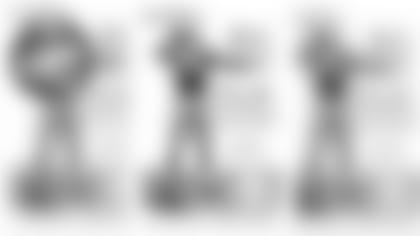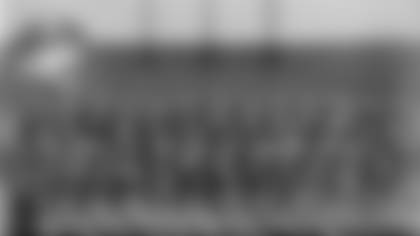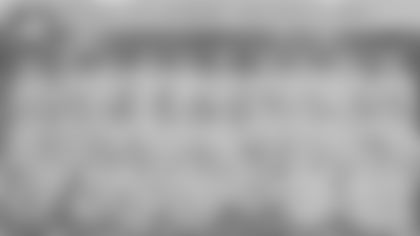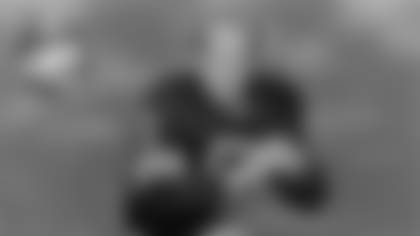Ron from Broken Arrow, OK
In looking through the Packers media guide, I see that in 1975, Willard Harrell threw three touchdown passes in five attempts, covering 61 yards. I presume these passes were likely on the "halfback option" play. How in the world did this happen on an otherwise less than successful team during Bart Starr's first season as coach? Did the opposing team not see this on film after it happened the first time? Or was Harrell just a gifted passer? I also find it interesting that the Packers' starting quarterback that season, John Hadl, threw only six TD passes. Should Bart have considered moving Harrell to quarterback?
First, here's a reminder of what Vince Lombardi wrote in "Run to Daylight." He called the halfback option "the greatest play in football." In addition, in a June 4, 1963, Milwaukee Journal story, Lombardi called it "the most important play in our offense."
As a first-year coach who had been Lombardi's quarterback for nine seasons, when the Packers won five NFL titles, it's not surprising that Starr would have wanted to include the halfback option in his playbook, even if it was becoming an obsolete play.
In Lombardi's offense, the halfback option (Red Right 49 Sweep Pass) was a twin play to his signature power sweep (Red Right 49 was the call). As he explained in "Run to Daylight," when he became backfield coach of the New York Giants in 1954, he was new to the NFL and had not even seen many pro games. Thus, prior to his first season, he immersed himself in film study and "that option play was one of the first things I put in" the playbook, Lombardi wrote.
Frank Gifford was the one Giant Lombardi was somewhat familiar with after facing him as an assistant at Army in 1951 when it played Southern Cal. "I knew that as a college Single-Wing tailback he had been not only a great runner but a fine passer," Lombardi wrote. That's the genesis of the halfback option. "The optional run-or-pass is basically a Single-Wing play," Lombardi added in "Run to Daylight."
Here are two more Lombardi quotes in reference to the halfback option. "Everything is made to look exactly like the sweep," he wrote in "Vince Lombardi on Football." In the same book, he also wrote, "In fact, if you want to make the sweep go you must be able to execute the halfback option where the back can either run or throw."
That's why the Packers almost never flip-flopped their backs other than in what former quarterback Zeke Bratkowski said was a Green formation, where Taylor could run the sweep to the strong side. Bratkowski said Taylor "maybe ran it every 100 plays" from split backs. Hornung was bigger than Taylor and fullback was his best position in the pre-Lombardi years. But Taylor couldn't throw and never attempted a pass.
What I would add to Bratkowski's comments is this: I wonder if in 1963, when Hornung was suspended, if the Packers didn't run the strong-side sweep more often from the Green formation and also if Taylor didn't run more weak-side sweeps than usual. For example, in the 1964 "Run to Daylight," film, during the segment where Lombardi talked about his power sweep, the film showed two plays, both with Taylor carrying the ball.
My hunch is that could have been for a combination of reasons, including the one above. Another might have been that what is now NFL Films didn't start shooting regular-season games until 1963 and wouldn't have had any of their own action shots of Hornung, other than from the 1962 NFL Championship Game, the first it ever filmed. Also keep in mind, Bratkowski wasn't acquired on waivers until the eighth game of the 1963 season.
At fullback, many of Taylor's prime runs were back to the weak side, including a weak-side sweep that was one of several plays Lombardi referred to as "adjustments to the sweep." They were used, according to Lombardi, when "teams began making defensive plays that were unusual but effective in stopping the sweep," but that also required "unusual (defensive) adjustments" leaving them "vulnerable" to other plays in his playbook.
Several years ago, I visited the Pro Football Hall of Fame in Canton, and it had a video display of Lombardi's power sweep, and I think most of the plays had Taylor carrying the ball. Moreover, not all of Hornung's runs were sweeps. Obviously, whoever put that together didn't know what they were doing. Nor do the stat geeks who scoff at Hornung's induction into the Pro Football Hall of Fame have any clue about his role in the offense.
"I've been fortunate to coach a couple of great all-around backs who made the sweep their personal play," Lombardi wrote in his book on football. "Though neither had that blinding speed they both were quick, intelligent runners who could 'control' their running so that they used their blockers and got every possible yard out of each play."
Back to Harrell's option passes.
What you might find even more intriguing is that his three touchdown passes came in three consecutive games, and all three were caught by wide receiver Steve Odom. On Nov. 16 vs. Detroit, a Harrell-to-Odom option pass covered 24 yards. On Nov. 23 against the New York Giants, the play covered 23 yards. On Nov. 30, Harrell and Odom hooked up on a 14-yard pass against Chicago.
The first one against Detroit came on the first play following an interception, and Odom caught the ball standing all alone in the end zone after the safety shot up to force against the run and the cornerback bit on the play, as well.
The second one also was thrown on first down following a fumble recovery at the Giants' 23, and Odom was again wide open. "When you're running that sweep and have some sort of success, the defense starts reacting and overreacting, and becomes too aggressive," Starr said after the game. Although lefthanded and better on throws to his left, Harrell was heading right on his pass against the Giants.
On the third one, climaxing a 64-yard drive, Harrell lobbed the ball over three defenders. By then, the opposing defense had caught on but couldn't stop the play.
The Packers won only four games that year and two of them occurred in that three-game stretch. They beat the Giants, 40-14, and the Bears, 28-7. That said, the Giants finished 5-9 and the Bears, 4-10, that season.
It's also worth noting that Harrell's first option pass was thrown in the sixth game against Pittsburgh and could have been a game-winner in what turned out to be a 16-13 loss to the eventual Super Bowl champions. With 10 minutes left and the score tied, Odom broke free behind the secondary and Harrell overshot him on what could have been a 56-yard catch-and-run touchdown. "If it had been a calm day without the wind Willard had at his back, it would have been a touchdown," Odom insisted after the game.
Hornung had an uncanny knack for running wide under control and being able to both key his blockers while also eyeing the safety to see if he was going to come up hard to force the run. While I can't picture Harrell's halfback option passes like I can Hornung's, he must have been blessed with some of those same traits, although he was more speedster than a run-to-daylight back.
Here's the reason the option pass was effective: The halfback was supposed to throw only when he saw the safety come up quickly to play the run. And when he did, as Lombardi put it, "the flanker will be all alone downfield and it's six points." Otherwise, the tight end also was an option on a 12- to 15-yard flat route after releasing from his block on the outside linebacker.
If neither was open, the halfback was instructed to pull the ball down and continue to follow the block of the lead guard, just as he would on a sweep.
Under Lombardi, from 1959-66, Hornung completed only 23 of 48 passes for 382 yards, a 16.6 average per completion, and five touchdowns. But perhaps just as important was the additional rushing yards gained on halfback option plays where Hornung – or Tom Moore, his backup – didn't throw. In 1962, for example, the Packers threw the ball only 13 times on the halfback option. But, according to Lombardi, "We ran it 70 times."
In 1962, the Packers went 13-1 and won the NFL championship with Starr throwing only 12 touchdown passes. Thus, Starr admitted after the season that the power sweep/halfback option was critical to his and the Packers' success. "We run the option end sweep so well that the other team doesn't know if you're going to run or throw," he said. "Moore can throw, perhaps not as good as Paul, but he is a threat."
Basically, what it came down to in the Lombardi years was how Moore explained it: "I don't throw a picture pass, but I try to get it to the receiver. As the coach says, 'All you have to do is put it in the basket.'"
Larry McCarren, a third-year center on the 1975 team, said it was no different with Harrell. "I do know the guy throwing the ball has to be good enough to get it there, but the key to the play is a wide-open receiver," said McCarren. His recollection was the halfback option was part of a special package that the Packers used at the time. Rarely was the ball thrown deep, McCarren noted. Then again, with an open receiver, it also could lead to big gains after the catch.
In Harrell's final two seasons with the Packers, he was 2 of 5 on option passes with one more TD, plus an interception. After that, I think Starr put the play in mothballs, although Gerry Ellis and Eddie Lee Ivery threw a combined 10 passes in Starr's final three seasons when Bob Schnelker, a former assistant to Lombardi, was offensive coordinator.
If anyone is interested, I wrote eight pages on Lombardi's power sweep, as well as the halfback option, in Volume II of our four-volume history, “The Greatest Story in Sports.”
Doug from Neenah, WI
I just read that my hometown, Neenah, hosted a Packers intra-squad game in 1956. Apparently, spectator interest was low back then. Do you know if the game was held at the old Shattuck High School and which famous players participated?
Let's start with the date and location of the game.
It was played on Aug. 11, 1956, in Menasha, Neenah's twin city, at Butte des Morts Field, then the home football field for Menasha High School. It also was used at the time by Menasha St. Mary. Menasha High started playing its games at Butte des Morts recreational field in 1928, the same year Butte des Morts grade school was completed on Tayco Street. The field was located behind the school. In 1930, wooden bleachers seating 2,500 were erected and lights were installed, turning it into more of a high school stadium.
Why did the Packers choose to play there?
The Packers started playing an annual intra-squad game in 1933 and most were held in old City Stadium when the Packers held their preseason practices in Green Bay. However, from 1951-57, the years they held training camp in Grand Rapids, Minn., and Stevens Point, Wis., the Packers held intra-squad games in a number of cities. Duluth and Hibbing, Minn.; Iron Mountain, Mich.; Elkhart, Ind.; and Grand Forks, N.D., were among them when they held camp in Grand Rapids.
When the Packers trained in Stevens Point from 1954-57, they played three games there and also one in Marshfield, Wis., in 1955. In 1956, they selected Janesville, Wis., and Menasha as game sites.
That was the last year the Packers played in old City Stadium. They also hadn't had a winning season in eight years, and they were still looking to grow their fan base. Pro football wasn't exactly a big business, either. The Packers' net profit in 1956 would be $28,683.
As to why the Packers chose Menasha over some other Wisconsin city, I can't tell you. But I would suspect some of the reasons included new lights having been installed at Butte des Morts Field a year earlier to accommodate an 8 p.m. kickoff; the city agreeing to erect temporary end-zone bleachers to increase capacity to 4,000 or more; the Neenah-Menasha Elks Club taking on sponsorship of the game; and recently elected Packers board member Huge Strange, a Neenah resident, handling the organization of it.
Why not Shattuck Field, Neenah High's home? I don't believe it had lights for a night game, although the late Menasha sportswriter George Mancosky wrote in 1999 that Butte des Mortes Field never had a scoreboard or a game clock.
Some of the Packers who played that night included three future Pro Football Hall of Famers: rookie quarterback Bart Starr, center Jim Ringo and safety Bobby Dillon. Future Packers Hall of Famers who saw action included: offensive end Gary Knafelc, quarterback Tobin Rote, halfback Al Carmichael, defensive end John Martinkovic, defensive tackle Dave Hanner, linebackers Bill Forester and Deral Teteak, and defensive back Hank Gremminger.
Rookie tackles Forrest Gregg and Bob Skoronski, who had played in the College All-Star Game the night before, were in uniform but didn't play.
As for the game itself, the Golds, coached by assistant coaches Lou Rymkus and Abe Stuber, beat the Greens, coached by aides Scooter McLean and Earl Klapstein, 32-21, before a crowd of more than 4,000 fans, who had paid $2 for their tickets. Head coach Lisle Blackbourn watched from the press box.
Rote started at quarterback for the Greens and completed 2 of 5 passes for 50 yards. He also ran for 30 yards on a fourth-down quarterback sneak. Starr started for the Golds and completed 3 of 7 passes for 50 yards. The most impressive of the quarterbacks was third-year pro Paul Held, who was competing with Starr for the backup job. He completed 12 of 21 for 164 yards. Carmichael was the leading rusher with 56 yards on seven attempts; Knafelc scored two touchdowns on receptions of 14 and 28 yards; and Forester scored on a 24-yard fumble recovery.
The promotional efforts included Blackbourn speaking to the Menasha Rotary and Martinkovic to the Neenah Rotary in June; the Gold team being touted as representing Menasha and the Green team, Neenah; and game officials who included legendary Neenah and Menasha high school coaches Ole Jorgensen, Eric Kitzman and Ralph McClone. Following the game, the Elks hosted players and coaches with a smoker at their clubhouse.
One of the better stories coming out of the entire affair was when Blackbourn spoke to the Rotary at the Menasha Hotel on June 6, 1956, and bemoaned the lack of progress on where to build Green Bay's new stadium (now Lambeau Field) because of the city's bitter divide: East Side or West Side. "Building one over the river would be the only way to satisfy all Bayites," said Blackbourn.
Again, that's one of my all-time favorite Packer stories and another that I wrote about in detail in our four-volume set.
Bill from Des Moines, IA
Who was the last true player/coach for the Packers and when? Did other teams in the NFL have player/coaches later than Green Bay?
The answer to your first question is Forrest Gregg. He was a player-coach in 1969 and '70. He was offensive line coach in '70 and played in 14 games. The year before that, he assisted Ray Wietecha with the offensive line and started all 14 games. Prior to Gregg, Don Hutson was officially listed as a player coach in 1944 and '45.
The Dallas Cowboys website claims Dan Reeves was the last in the NFL. He was offensive backfield coach from 1970-72, while playing in all 42 of the Cowboys' games, although he started only one.














